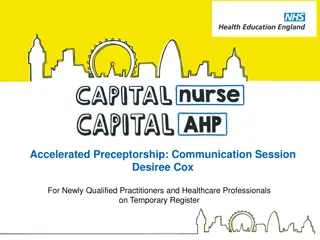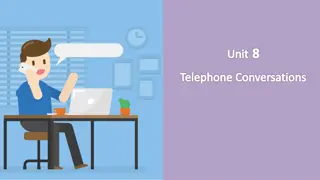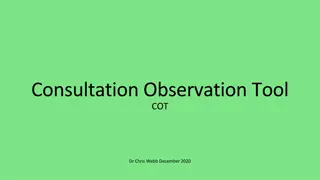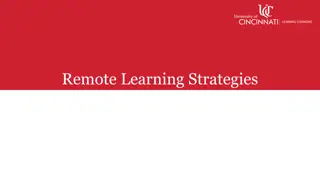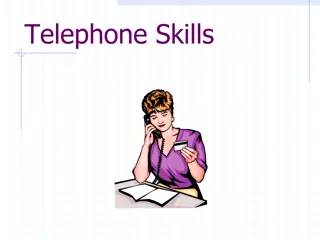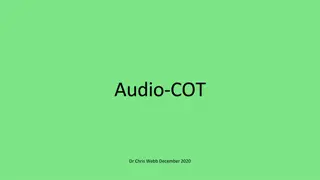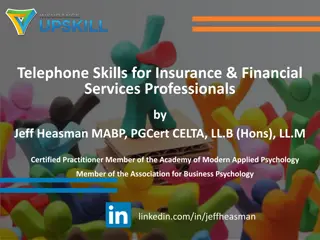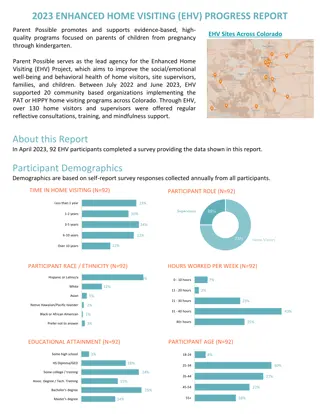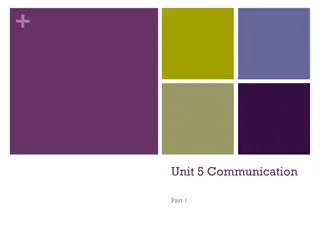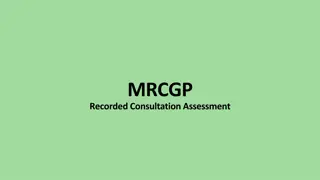Mastering Telephone Consultations: Tips and Key Skills for Effective Remote Communication
Explore the world of telephone consultations with insights on benefits, pitfalls, and essential skills. Discover strategies for successful remote communication, understanding patient needs, and ensuring confidentiality. Enhance your ability to connect, explain clearly, and problem-solve in various scenarios. Find guidance on setting the scene, utilizing technology, and optimizing the consultation experience for both you and the patient.
Download Presentation

Please find below an Image/Link to download the presentation.
The content on the website is provided AS IS for your information and personal use only. It may not be sold, licensed, or shared on other websites without obtaining consent from the author. Download presentation by click this link. If you encounter any issues during the download, it is possible that the publisher has removed the file from their server.
E N D
Presentation Transcript
Telephone Consultations Abid Iqbal and Lucy Clark
Plan for Afternoon Introduction to topic Aims Quiz Overview of remote consultation Practice run in small groups
Intended Learning Outcomes Brief overview of telephone consultations Focusing on benefits and pitfalls Role play of telephone consultation in small groups All Capabilities can be covered- primarily looking at CS&C, DG, D&D CM but touches on every aspect except CEPS
Please think of 2 positives for telephone consultations and 2 negatives (these can be for you or the patient) Write them down so you can hold them up to the camera for us to collate
Key Skills for Consulting on the Phone Connecting Being able to understand and relate to all ages and all levels of understanding Explaining things in a simple easy to understand way Key to this is experience and broad work experience Critical thinking Listen, assimilate, collate, prioritise Team working Working together, being aware of where to send patients and how best to help them Problem solving
Telephone Consultations- tips and help 1. Setting the Scene Is a telephone consultation appropriate? Consider -The Patient- language barriers, LD, hearing difficulties- what can you do to facilitate these situations? -The Reason usually some situations require an examination e.g. acute abdomen- breathlessness etc We are currently assessing these patients over the phone some tips later.
The Tech Think about your environment; Sound proofing Background Confidentiality- of the patient and others- who s at the patient s house? Headsets Sharing info Short cuts Typing noise/ ability to touch type/ focus on 2 things at once - ensure explain why massive silence while tapping on keyboard!
Connection Introduction ID check Document telephone consult Is this a good time? Is the patient in Morrisons? Is the patient able to talk freely? Is the patient safe? Ideally talk to the patient- if third party why? Encourage 3 way on speaker if family member translating Language line will call patient and arrange 3 way- long but works well Safeguarding think about what you can t see Covered in handout sent- see this for more info.
History taking Initial open Q How can I help today Allow opening monologue- patient will have prepared this often. Avoid interrupting this if possible. Much fewer cues given over the phone- consulting blind . This can feel very disconcerting and can often cause increased uncertainty in the doctor Check they have no other issues early in call Ensure you understand the patient s ideas concerns and expectations often patients will have researched their symptoms and have a good idea of what they think the problem is. Double check history- validates above and ensures full story, allows patient to correct mistakes Don t waste time- if they need to come in- or need an ambulance just do it.
Safety Q and Red Flags Really important ( the visual clue of a ghost-like cachectic patient sat in front of you is not there- so you must remember to screen patients) Examples; Back pain- ensure cover malignancy, cauda equina, infection, fracture UTI- ensure cover ascending infection, prostatitis, sepsis Ensure document negative findings
Past History and Medication You may have access to this all via the patient notes If not -its important to ask about all medication and PMHx Don t assume patients have been taking their medication regularly Check otc medication
Verbal Examination Patients physical state is unreliably assessed over the phone Tone of voice, rate of speech & breathing can indicate to some extent emotional and physical condition of patient Patients often have BP pulse (smart watches) and sats equipment which is helpful- but their ability to read these and reliability of readings important to qualify (Story of Monica s Mum) Quantifying patients descriptions is important- breathlessness- what s their usual? And compared to now? Assessing children can be scary- it s important to assess parents too- are they first time parents? Do they realise that their child is ill?
Assessment for Covid -19 Temp? Fever or chills/ shakes or sweats Does chest feel hot? Where are they? Are they in bed? Chest pain- tell me abut it (usual questions around inspiration and exertion) Breathlessness- is the patient able to speak in sentences? Can you do usual activities? Are you up and dressed? Are you able to walk on the flat e.g. to the toilet? is this new for you? Can you walk up the stairs? Is this a change from normal? (some patients live in flats- have backpain etc- this needs to be clarified) Can the patient take their own pulse? Sats? temp?
Management Explain dx clearly - even harder for you to know if patient is understanding than normal Link explanation to patients ideas concerns and expectations Outline options slowly and clearly Don t forget lifestyle advise In current Corona virus situation due to challenges with monitoring avoid high risk px ie those with abuse potential, those unsafe in overdose, and those with narrow therapeutic window
Safety netting Ensure heard and understood Share uncertainty Document Be clear with instructions Specify what you would expect normally with time frames and what to look out for ( linking back to red flags asked earlier is helpful- or explaining red flags as you go so patient understands then recapping them here) Don t say if it gets worse call me back Try if temp remains at 38 c by 10pm call .
Active Listening Ensure listening to patient attentively Take notes to stay focused- it s very easy to get distracted from call Saying things like I see.. I understand , even yes and mmmm encourage contribution and inform patient you re listening. Summarise and recap -this validates patient and checks correct understanding on docs part Calling someone you don t know very well can be quite stilted and challenging- it s your job to put the patient at ease and ensure they tell you all the information you need to care for them safely Its also important they know when and why they need to contact you again
Types of Question Closed- yes/no Compound closed- was the pain dull or sharp? Open ended- can you tell me about the pain? Probing when this first happened what did you feel? Leading you don t have chest pain do you? You don t feel like harming yourself do you? Helpful to have a reason to the question- Is you baby feeling hot? It helps to know how to help her best Remember the tone and the confidence of your voice are important Use the patients name- it s very powerful
Keep sight of what you are aiming for And what the patient wants Take breaks Do some burpies/stretch Telephone consultations can be draining.











